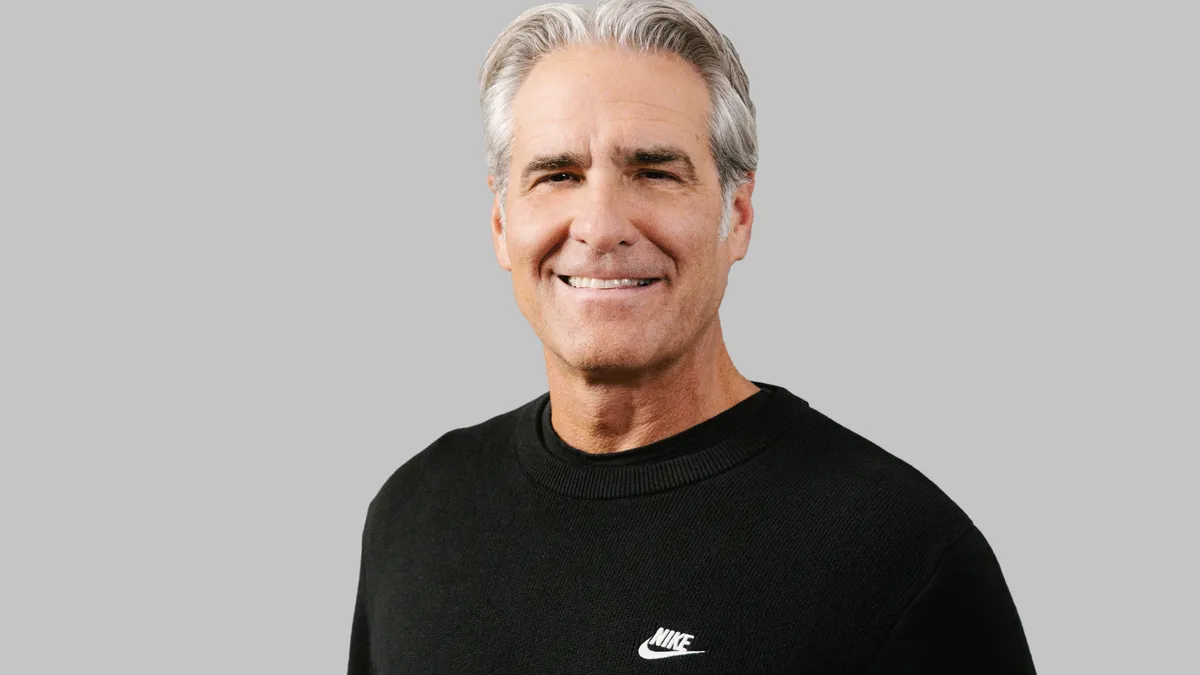Eight months into his tenure as Nike’s CEO, Elliott Hill's leadership team is now set, according to a company spokesperson. That has included more than ten notable title changes, retirements and additions to Nike’s leadership ranks over the past few months.
Matt Powell, an adviser with BCE Consulting, said via email that the chief executive has been “thoughtfully building his team to execute the turnaround,” which is centered on rebuilding relationships with wholesale partners and rightsizing key footwear franchises like Air Force 1 and Dunk. Sales in the retailer's most recent quarter tumbled 9%, just the latest in a string of declines at the activewear giant.
“Mr. Hill will be tasked with executing these changes and winning back market share lost to competitors that filled shelves left by Nike’s vacancy,” S&P Global Ratings’ analyst Amanda O’Neill said in emailed comments in September. “Specifically, Nike has lost its footing in the specialty running category, specifically losing market share to newer entrants Hoka and OnRunning, and legacy competitors Adidas and New Balance have retained their positions in the lifestyle category.”
Hill, who retired from Nike in 2020 after a lengthy 32-year tenure with the activewear giant, isn’t shying away from change during his second Nike stint, especially when it comes to the executive leadership team.
In early October, just before Hill took over, Nike featured 12 executives on its leadership page, including then-CEO John Donahoe and Hill, alongside Chairman Emeritus Phil Knight and Executive Chairman Mark Parker. Now, eight months later, just three executives remain in their same role, excluding Knight, Parker and Hill. The leadership team has grown to 14 executives, the majority of which are either new to their title or top-line leadership role at Nike. The page as it stands is reflective of Hill’s direct leadership team, though other notable appointments have also been made across the organization, a spokesperson said.
In all the hubbub, four executives with 26-plus years of experience have announced their retirements since Hill joined, including marketing lead John Slusher, Chief Human Resources Officer Monique Matheson, Chief Innovation Officer John Hoke and President of Consumer, Product and Brand Heidi O’Neill. But even with those departures, the team Hill is building remains largely Nike-centric.
Everyone on Nike’s leadership page currently is a Nike veteran; in fact, the only notable appointment Hill has made externally is for the brand’s new chief communications officer. Michael Gonda arrives in early July from McDonald’s and his only other experience at a major brand is at yogurt maker Chobani.
Nike's leadership ranks have seen widespread change since last fall
-
Sept. 19, 2024Nike announces John Donahoe will retire as CEO effective Oct. 13 and Elliott Hill will replace him on Oct. 14.
-
Oct. 10It was announced that Tom Peddie, who spent more than 30 years at Nike and retired in 2020, would return to take on the role of general manager of the North America geography on Oct. 21. He replaces Scott Uzzell, who spent six years total with the company.
-
Oct. 14Elliott Hill comes out of retirement to take over as CEO.
-
Oct. 30Nike names Ann Miller, an executive with 18 years of experience at the company, as its executive vice president of global sports marketing, replacing retiring 26-year veteran John Slusher. At the same time, 20-year Nike veteran Rob Leinwand replaces Miller as chief legal officer and Chief Supply Chain Officer Venkatesh Alagirisamy becomes a member of the senior leadership team.
-
Nov. 25Chief Human Resources Officer Monique Matheson announces her retirement after 26 years with the company, with 13-year Nike veteran Treasure Heinle taking over the role.
-
April 23, 2025Jennifer Hartley, a 14-year Nike veteran, is named chief strategy officer. She replaces Daniel Heaf, who later becomes CEO of Bath & Body Works.
-
May 5Nike announces President of Consumer, Product and Brand Heidi O’Neill will retire after 26 years with the company and her role will be broken into three areas. At the same time, Amy Montagne is named president of the Nike brand, footwear vice president Phil McCartney becomes chief innovation, design and product officer, and Tom Clarke, a strategic adviser to the CEO, is named chief growth initiatives officer.
-
May 30Chief Innovation Officer John Hoke announces his retirement after over 30 years with the company. Tony Bignell, who has spent more than two decades with the retailer, replaces him in early June.
-
June 2McDonald’s veteran Michael Gonda is named chief communications officer, replacing KeJuan Wilkins.
Other than Gonda, much of the team Hill has assembled has decades of experience at Nike — something analysts flagged as a bonus when Hill was named to the top spot last fall.
“While fundamentals will be very challenged in the near-term, we believe that it takes a back seat to the narrative, which is that of a veteran athlete coming out of retirement to pull his once-proud team out of the dumps,” Needham analyst Tom Nikic wrote in December, after Hill’s first earnings call as CEO.
Additionally, Hill’s adjustments so far highlight a few structural changes in the way Nike is doing business. For example, the chief executive elevated Chief Supply Chain Officer Venkatesh Alagirisamy to the senior leadership team in October and in May separated O’Neill’s responsibilities for consumer, product and brand into three distinct roles that will all report to Hill individually.
Nike has new marketing and communications leads, and three different C-level roles that arguably all handle innovation: a chief innovation officer, a chief growth initiatives officer and a chief innovation, design and product officer.
These notably reflect some of Nike’s top turnaround priorities: product innovation and brand storytelling.
Likewise, Nike is tackling its DTC-wholesale mix with new leadership. Hill in March said he worked with Craig Williams, who leads Nike’s geographies and marketplace, to institute new leaders for Nike Direct and Nike Wholesale. Shannon Glass was named vice president of Nike Direct in January, per her LinkedIn, while Erica Bullard serves as her counterpart on wholesale.
Hill described them both as “long-term industry veterans and Nike veterans” and said he’s tasked them with working closely together after Nike’s previous DTC-wholesale missteps led to some of the challenges it’s currently facing.
“In fact, we even put them sitting … up on our floor together. They have offices right outside of one another,” Hill said on the earnings call in March. “I told them those two have got to walk together everywhere they go and make certain that we stay aligned. And I think they're doing a tremendous job of really making certain that we have an integrated approach to the overall marketplace.”
Saying is one thing, but doing is another — and the Nike turnaround will likely take time, GlobalData Managing Director Neil Saunders said in emailed comments in September.
“Nike has a long road to travel in order to compete more successfully against younger, nimbler brands. And its reinvention coincides with a period of soft sneaker demand,” Saunders said. “Hill likely has the skill and vision to turn the business around, but this will not happen overnight. A change of jockey does not automatically put the Nike horse out in front.”





















